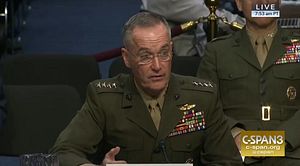Speaking on Tuesday, U.S. Chairman of the Joint Chiefs of Staff General Joseph Dunford said that the United States should “assume now that North Korea has the capability” to strike the United States’ homeland with a nuclear weapon on an intercontinental-range ballistic missile (ICBM).
Dunford was speaking at a hearing before the Senate Armed Services Committee concerning his reappointment. He noted that while certain aspects of North Korea’s ballistic missile systems had yet to be fully tested and developed, these were “engineering solutions that will be developed over time.”
He specified that some of the capabilities he believed have not yet been finessed by North Korea include reentry vehicle technology and flight stabilization for its ballistic missiles.
He was responding to a question from Sen. Deb Fischer about the capabilities shown by North Korea on July 4 and July 29, when it carried out the only tests to date of its new Hwasong-14/KN20 intercontinental-range ballistic missile.
Dunford is the senior-most U.S. figure to recommend that the United States accept that North Korea would be capable of striking the United States with a nuclear-tipped ballistic missile today for policy planning purposes.
Earlier in September, General John Hyten, the head of U.S. Strategic Command, said that the United States should assume too that the device North Korea tested on September 3 was a hydrogen bomb as it claimed, based on the size of the blast.
The United States’ assessment of that nuclear test—North Korea’s sixth to date — is ongoing.
In the remainder of his hearing, Dunford recommended improvements to U.S. ballistic missile defense capabilities in light of the North Korean—and other—threats.
The United States currently has one operational missile defense system — the Ground-Based Midcourse Defense system — that is capable of intercepting incoming ballistic missiles like the KN20.
The system has been successfully tested against an ICBM target just once, earlier this year. It’s overall record in testing is poor at 50 percent.

































